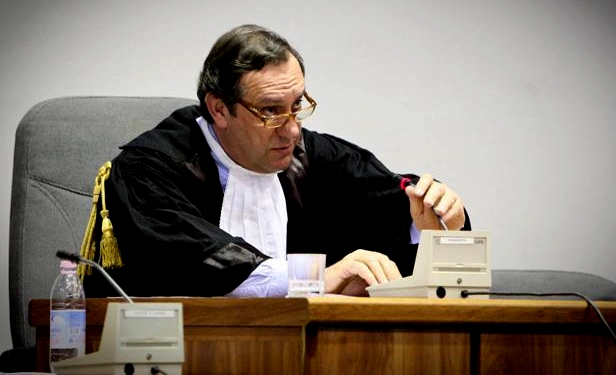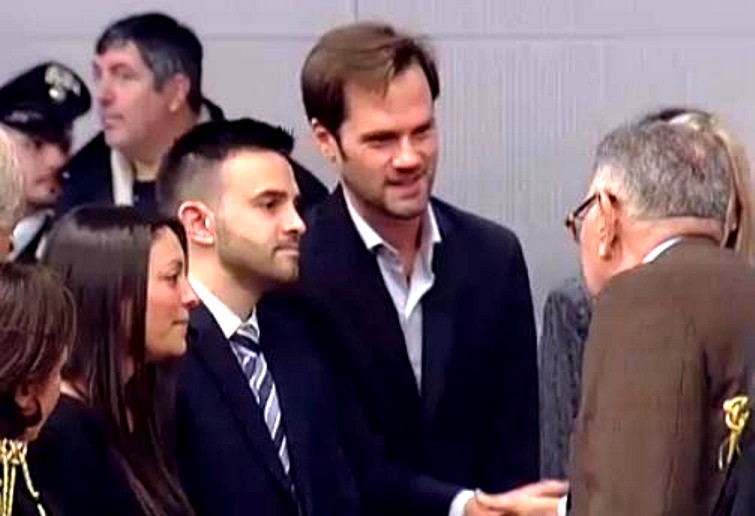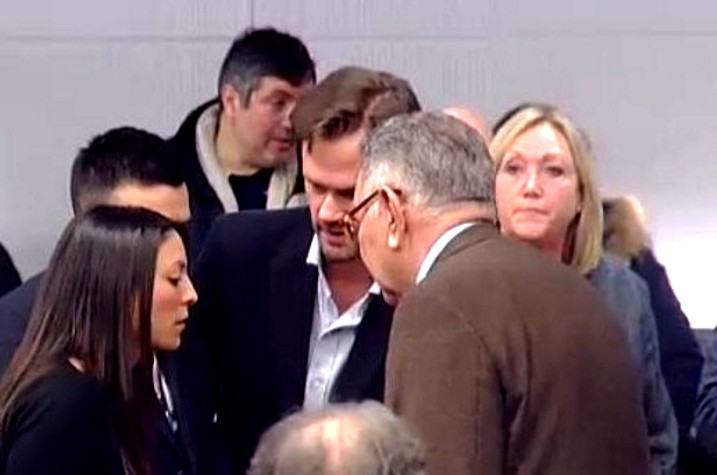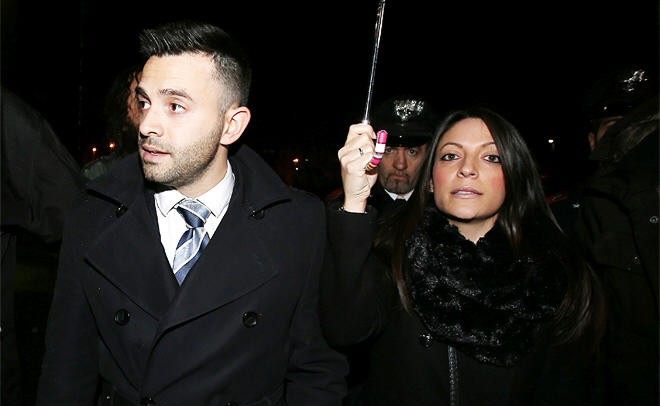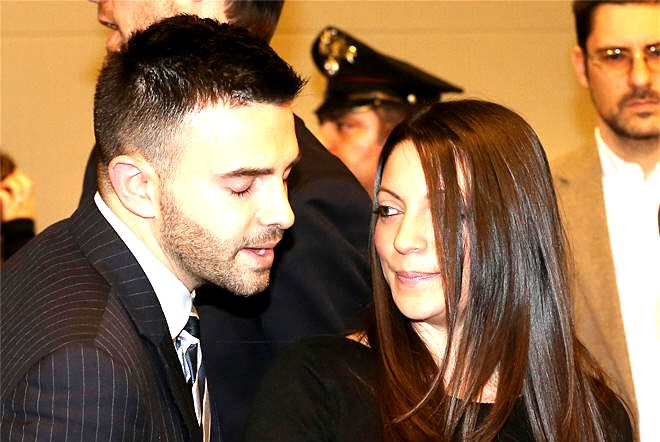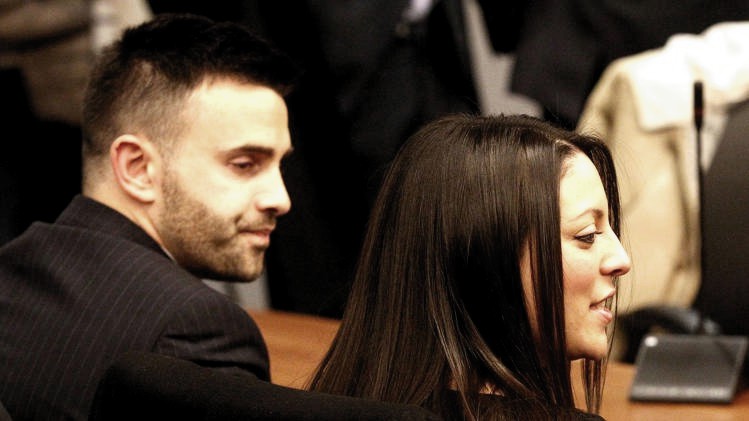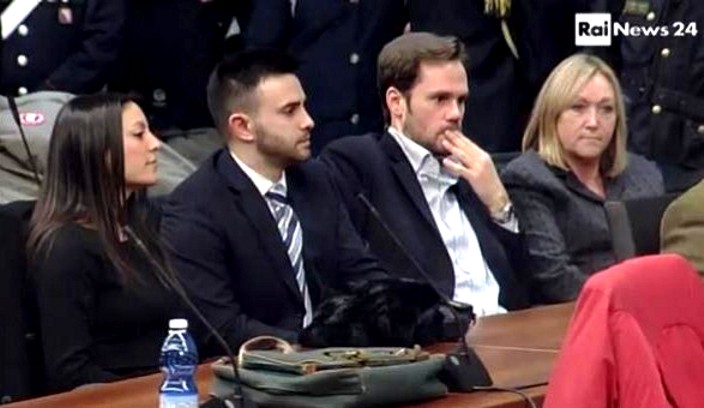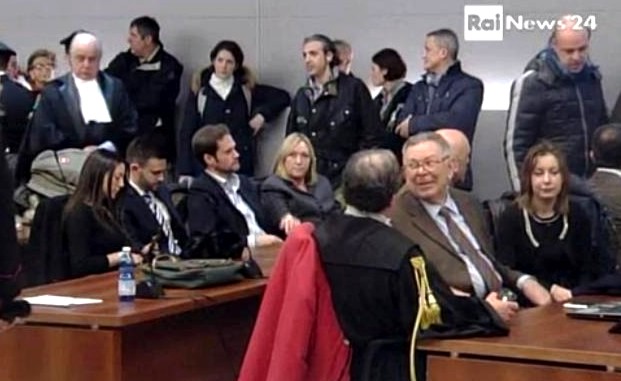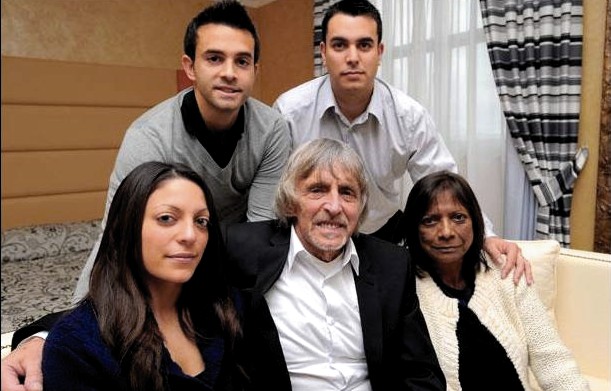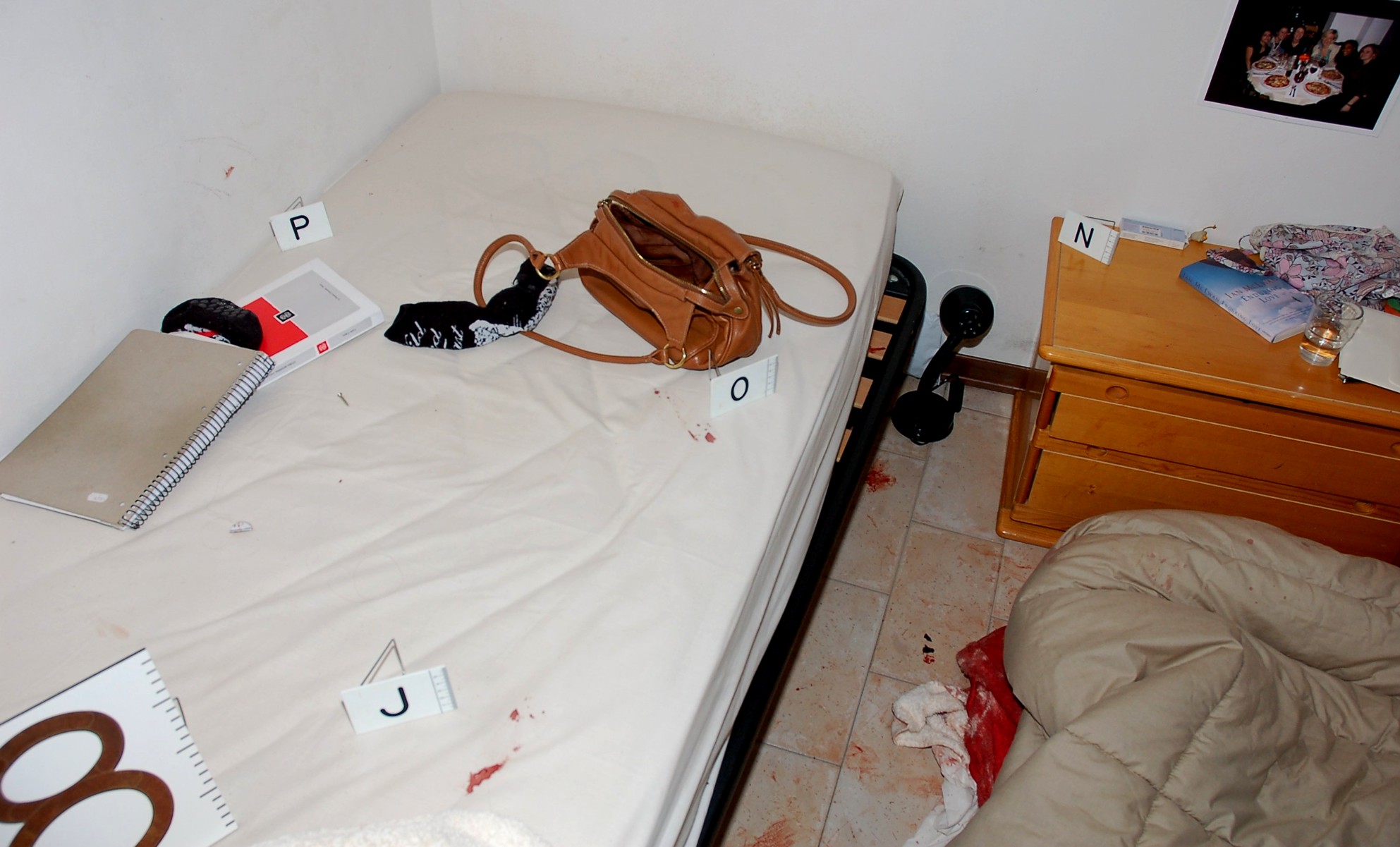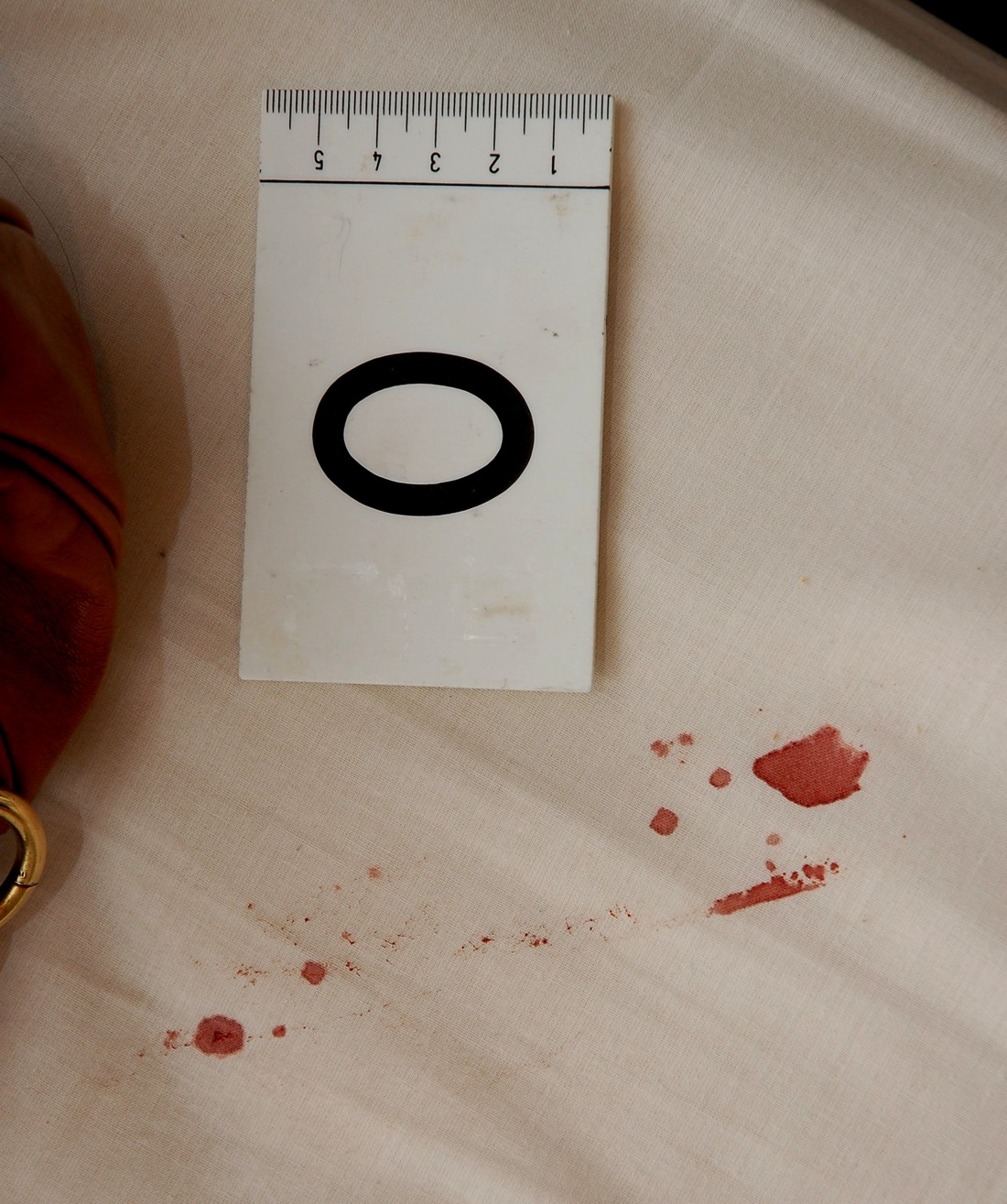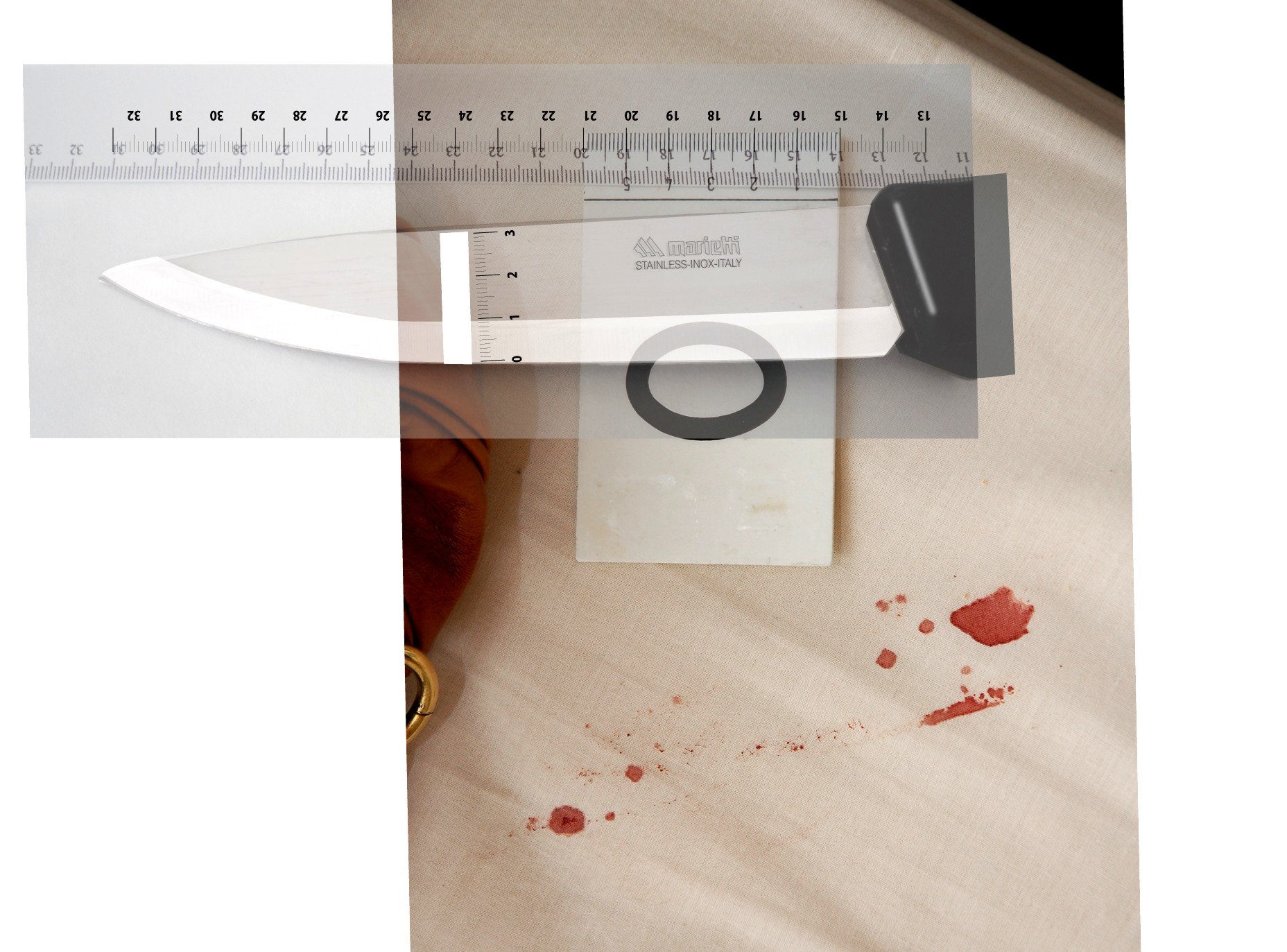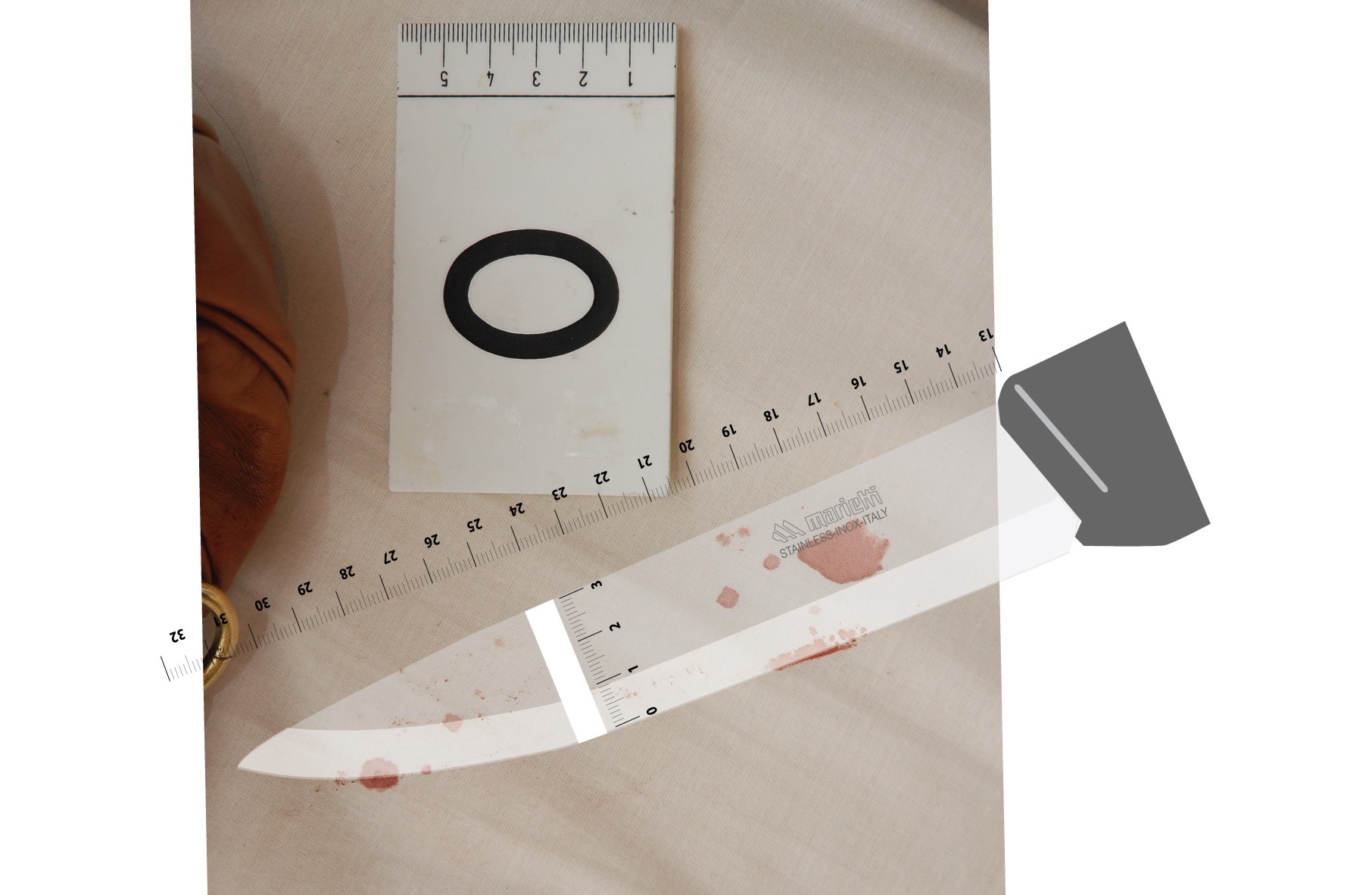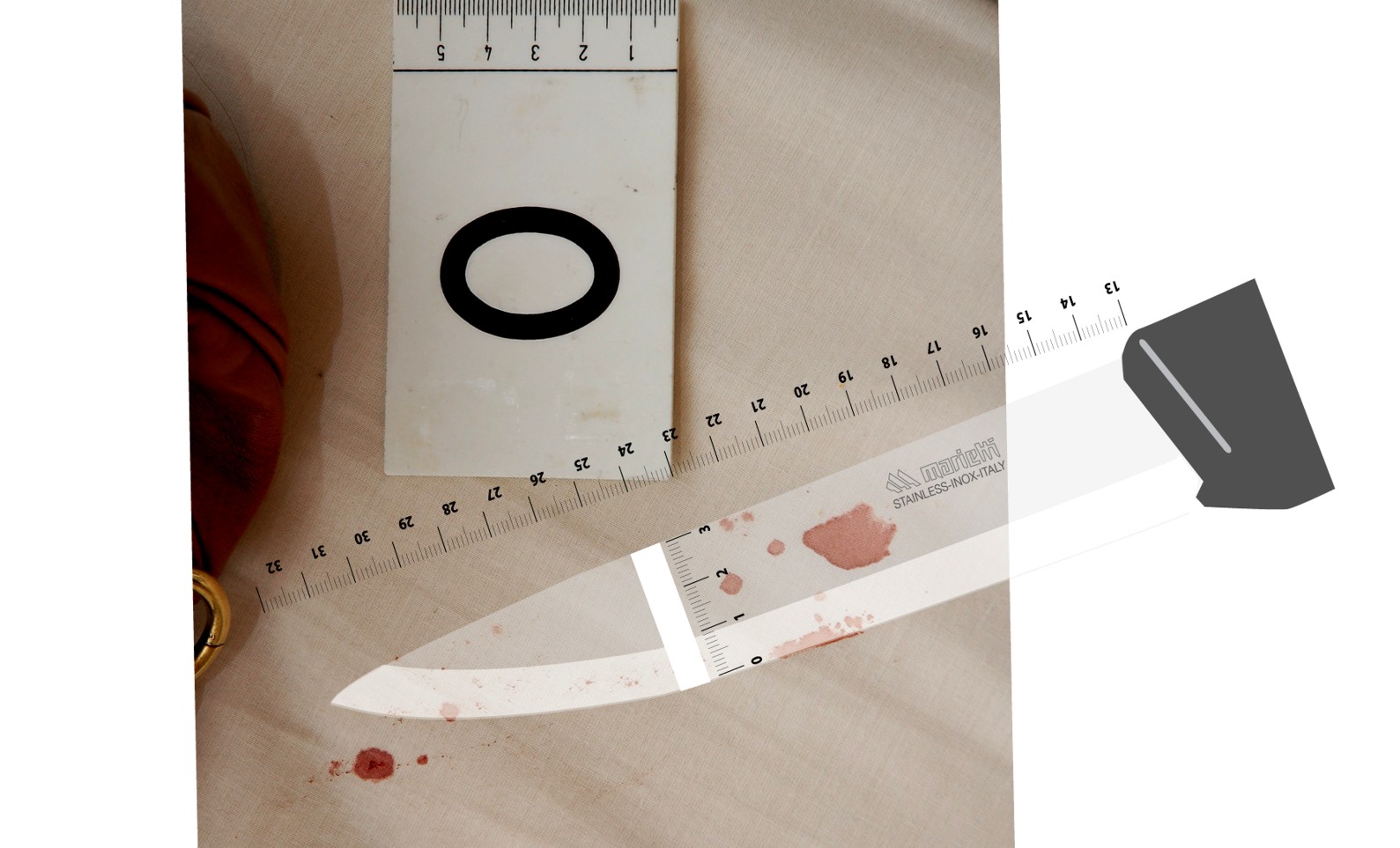
Tuesday, February 04, 2014
Defense Dirty Tricks: Did We Just See Yet Another One, An Attempt To Compromise Judge Nencini?
Posted by Jools
Judge Nencini offers corrections
This is my translation of a statement from Judge Necini carried by the Florence GoNews website.
“In relation to the press articles that reported my statements on the trial for the death of Meredith Kercher I intend to point out that there has been no interview organized or pre-arranged.
I ran into some journalists in the corridors of the courthouse who told me of the rumors and speculations that were being circulated on the duration of the deliberation session.
I then had a brief talk with them meant, in my intention, to clarify possible misunderstandings. In this I accept responsibility, reaffirming that I did not agree to disclose in any way the reasons for the sentence. In particular, I have not expressed any opinion on the strategy procedure followed by the defence of the accused.
In fact the only reference to that matter, reported in the article that appeared in Il Messaggero, is one in which I stated that the accused were defended in the process to a ‘very high standard.’
If my words have generated misunderstandings on this point and on the absolute legality of the choice of an accused to make spontaneous statements I regret it.
These explanations are dutybound for the respect I owe to the people who participated in the process with me and to the [Law] System of which I’m proud to be a part of; as well as for consistency in my professional history, with over thirty years of work carried out without spotlights and without interviews.”
Context for those corrections
This is in relation to the previous days articles claiming Judge Nencini supposedly gave an “inappropriate” interview to the press.
In very short order three or four lay members of the Superior Council of Magistrates (CSM) laid a complaint about non-appropriate conduct (under Art. 6 of the CSM rules) for a presiding appeal court judge to give press interviews commenting on the motivations reached by the judges on any sentence before its official publication.
Not surprisingly, the first people to complain were Bongiorno and Maori (grasping at straws, much?!!) and then to follow were these three or four lay members of the CSM, who happen to be also members of the centre-right political party “Forza Italia” (Berlusconi’s party).
As a result of the complaint made by these people, the Justice Minister, Annamaria Cancelleri, ordered an inquest on the allegations against Judge Nencini which could have led to his reprimand for disclosing details of the verdict reached to the press.
Personally, I think this all results from the desperation of Sollelcito’s defense and they have erncourgaed the others to instigate it. Making a meal out of nothing, in the hope that the whole appeal trial gets thrown out.
And let’s face it, it wouldn’t be difficult for Bongiorno to find some of Berlusconi’s people that are always looking for ways to attack members of the judiciary given Berlusconi’s hatred for the system. Just my opinion…
In any case, the allegations seem to be false, Judge Nencini actually didn’t say much, and the inquest will prove it, but in the meantime the press is concentrating on this rather than the hopeless work the defense produced. This maybe is the whole objective.
The later, longer interview
The interview by Fiorenza Sarzanini with Judge Nencini the following morning is claimed to be quite legal, because the decision of the court had been published the previous evening.
Andre Vogt kindly posted a very accurate translation on The Freelance Desk, and as it will scroll down soon and be hard to find, we can repost the full interview here.
Posted 1 February
Italy’s most influential newspaper, the Corriere Della Sera, this morning has published a fascinating long interview with Judge Alessandro Nencini about his reasons for convicting Amanda Knox. The interview was done by one of the newspaper’s most veteran crime and investigative reporters, Fiorenza Sarzanini. Click here to read the original.
HEADLINE: Amanda and Raffaele: The Judge Speaks
SUBHEAD: “I have children too; it was a huge burden.”
SUBHEAD2: “The defense had asked to separate the positions of the two accused, but Raffaele would not allow himself to be questioned.”
By Fiorenza Sarzanini
“I feel relieved because the moment of the decision is the most difficult. I have children too, and handing down convictions of 25 and 28 years for two young people is a very hard thing, emotionally.”
It is 10 am the day after the verdict and Justice Alessandro Nencini is in his office. The President of the Florentine Court of Appeals, which two days ago found Amanda Knox and Raffaele Sollecito guilty of the murder of Meredith Kercher, knows that the decision will “open up new debate, especially in the media”, but that is exactly why he agreed to explain how the verdict was reached.
You deliberated in chambers for 12 hours. Was the judicial panel divided?
“The case files took up half of the room. There are 30 expert reports. The lay judges, who aren’t court staff, had to read all the documentation to reach a joint decision, as is expected in the appeals court. You have to review all the documents, think about them, and reason. We did that using all the time that was necessary, and taking into account the fact that the victim was also a young girl.
And then the decision was unanimous?
“I spoke of a joint decision. I can say that in all these months and in particular during the last session of deliberations, we carefully considered the gravity of a verdict that involves young people and their entire families. This is a case that has consumed many lives.”
Yours was a narrow path, the Court of Cassation had urged you to remedy the Perugia appeal decision that had acquitted the two accused.
“Not so, we had maximum flexibility. The only restriction was that in the case of acquittal, we would have to have give reasons based on logic. There was no other binding restriction.”
Not even with regard to the decision handed down in Rudy Guede’s case?
“Effectively the specifics of the case was this: there was a person already convicted via fast-track, and definitively, for concourse in the same homicide. The Court of Cassation was asking us to consider who participated and their roles. We could have said that the two accused weren’t there, and then provided convincing reasoning, but we did not believe this to be the truth.”
Why didn’t you question Guede?
“For what purpose? He has never confessed and even if we had called him, he had the right to remain silent. We didn’t think it was necessary. Rather, we felt it was important to study the other aspects more in depth. In fact we requested an expert report and heard witnesses about which there were doubts. That is the role of the appeal judges. In four months, we’ve been able to arrive at a result.”
Sollecito’s lawyers had asked you to split the defence.
“We’ll explain the point more in the reasonings, where we will explain why we rejected that request. In any case, Sollecito did not want to be questioned during the trial.”And this influenced your choice to convict him?
“It is the defendant’s right, but certainly it removes a voice from the trial proceedings. He limited himself to making spontaneous declarations, saying only what he wanted to say, without being cross examined.”
Over the years, various motives have been speculated. What idea did you yourselves form?
“We convicted and we will explain it explicitly in our reasoning. For now, I can say that up until 20:15 of that evening, these young people all had different plans, then their commitments fell through and the occasion for this to happen was created. If Amanda had gone to work, we probably wouldn’t be here.”
Are you saying that the murder was just a coincidence?
“I’m saying this was something that unfolded between these young people. There may have been coincidences, and we’ve taken it into the reasoning. I’m aware this will be the most debatable part.”
Cassation demolished the acquittal. Will you as well?
“We are not going to mention it. We simply have to focus on the decision in the first instance (Massei) which we confirmed, on the facts.
And you don’t believe that there were errors?
“I didn’t say that. Some I believe there may have been and I’ll point them out.”
You convicted Amanda Knox, but didn’t issue any precautionary measures against her. Why?
“She is legally in the United States. At the moment of the offence she was in Italy to study and she went home after having been acquitted. She is an American citizen. The problem will arise when it is time to carry out the sentence. For now I don’t believe that such a measure wouuld have been necessary.”
So why then have you confiscated Raffaele Sollecito’s passport?
“It was the agreed minimum. In these cases such measures serve as prevention. We want to avoid that he makes himself impossible to find during the period of waiting for a definitive judgment.”
And you believe being forbidden to leave the country is enough?
“Yes, that seemed more than sufficient to us. If there are other developments later, we will consider them.”
Monday, February 03, 2014
Authors Of “Math On Trial” Bring The Explanations Of The Hard DNA Evidence Up To Date
Posted by Peter Quennell
The important new book in question Math On Trial is by mathematicians Leila Schneps and Coralie Colmez who is Leila’s daughter.
This article by Leila Schneps appeared in yesterday’s edition of The Independent and explains why the Nencini court has not ruled out any of the DNA evidence.
It’s not right to say there is “˜no evidence’ in the case against Amanda Knox. There’s plenty
The DNA alone is enough to raise questions
The verdict handed down yesterday at the new appeal trial for Amanda Knox and her former Italian boyfriend, Raffaele Sollecito, accused of the murder of British citizen Meredith Kercher in Italy in November 2007, may come as a surprise to those whose view of the case has been affected by an international media blitz based on the oft-repeated claim “There is no evidence”. Many believe that Rudy Guede, convicted in October 2008 for participating in the murder, acted alone.
There is, however, copious evidence to consider: the DNA alone is enough to raise questions. Leaving aside much of it, let’s focus for a moment on three key pieces of DNA evidence and present them from both sides, just as the jury may have heard them spoken of in court.First ““ the bra clasp.
The part of the victim’s bra containing the hooks had been ripped or slashed from the rest of her bra. Not immediately collected on that first day after the murder, it remained in the room in a sealed house for six weeks before being sent to the lab in December. There, it was tested and found to contain a large sample of Meredith’s DNA, together with a smaller but clearly visible contribution from Sollecito. The defence objections: firstly, between the two searches, objects in the crime room had been moved around, and indeed the bra clasp was found about a metre away from its original position.
Secondly, apart from “˜alleles’ - genetic traces - of Meredith and Sollecito on the clasp, there were a few unidentifiable extra ones. Putting these two facts together, the defence pointed out that Sollecito’s DNA on the bra clasp could have been a consequence of a careless police technician stepping on Sollecito’s DNA elsewhere in the flat and then entering the room and stepping on the bra clasp, even though no DNA of Sollecito was found anywhere else in the house except on a single cigarette butt in the ashtray.
Second ““ the mixed stain.
Although not visible to the naked eye, the chemical Luminol which flashes blue on contact with blood revealed a spot in the room of the flatmate whose window had been smashed and room rifled. Swabbing the spot produced a mixture of Amanda and Meredith’s DNA. This is a clear proof that the murderer entered that bedroom after the murder, as someone must have brought Meredith’s blood into the room, contradicting the defence theory that Rudy Guede broke into the house and then committed the murder.
The usual defence explanation for mixed DNA stains in the bathroom and corridor, namely that the house would have been coated in Amanda’s DNA given that she lived there, does not necessarily apply to a flatmate’s bedroom. It is much harder to leave traces of DNA than is commonly conceived, and hardly any of Amanda’s DNA was found in her own room - where she surely spent a lot more time than in her flatmate’s.
Lastly ““ the knife.
Days after the murder, a large kitchen knife was seized in Raffaele’s flat, where Meredith had never set foot. Police geneticist, Patrizia Stefanoni, swabbed spots on the blade of the knife and on the handle in the knife’s first DNA Test. One spot in particular attracted her attention: a visible scratch on the flat of the blade. The swab taken from this scratch yielded a positive ID for Meredith Kercher.
By the third trial, when a new attempt was made to collect DNA from the knife (which had been swabbed again during the appeal trial, though no tests were then conducted) there was no match to Meredith ““ a result welcomed by Knox’s defence team, though it did not in fact impact on the findings of the first trial.
Stefanoni’s test ““ she only conducted the first - came under strong fire in the courtroom. Two independent expert witnesses called in for the appeal against Knox and Sollecito’s original 2009 conviction stated that she had not worked in conformity with standard international protocol. Indeed, standard protocol for DNA testing involves three steps: first determining how much DNA is in a sample, secondly amplification, which reproduces the sample millions of times, and thirdly electrophoresis which produces the familiar DNA graphs showing peaks in the location of an individual’s alleles. Under cross-examination, Stefanoni explained that quantification had given a result of “too low” as the machine she used that day was not the most sensitive one in the lab.
Knowing that samples undetectable by the machine can still be sufficient to yield positive results, she chose to continue with testing. At the second stage of testing, amplification, a sample will normally be split into two or more pieces in order to run independent tests. But knowing that the sample was small, Stefanoni feared that cutting it in two would yield no result at all, and chose to amplify the entire sample in one unrepeatable test. The end result was a perfect match to Meredith Kercher.
Knox’s supporters have claimed since the beginning that the accusations levied against her are based on the Italian justice system’s hatred of a pretty, American girl who likes parties and having sex. And whilst both parties protest their innocence , Thursday’s decision shows that there is real evidence against her and Sollecito, that cannot be ignored.
Guide For Smart Media: Note Extensive Hard Evidence In Exceptionally Fair, Careful Legal Process
Posted by Media Watcher
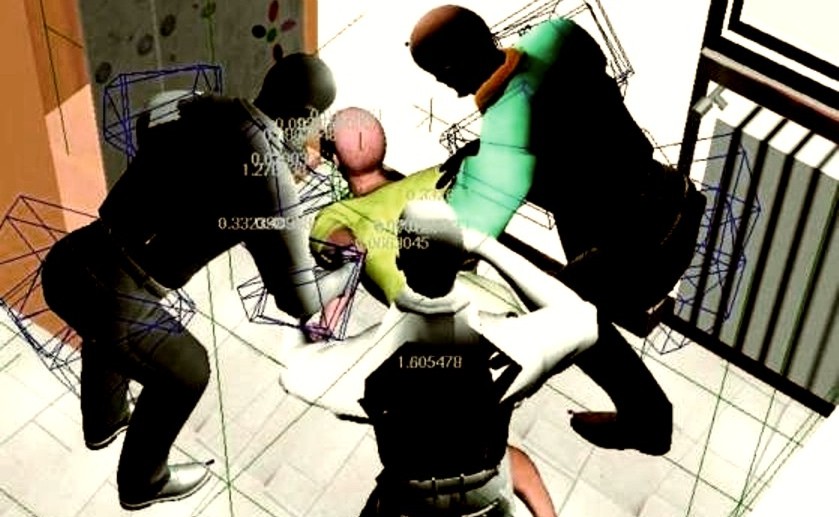
[Accurate Italian media recreation of attack based on masses of closed court evidence 2009]
Vital media history in 2009
In Italy and Europe generally the guilt of the two is almost universally perceived.
One reason is that although about 1/4 of the trial in 2009 was behind closed doors (quite the opposite of the “tabloid storm” and “show trial” Americans have been told about) Italians in particular got to find out about the long (15 minutes), remorseless, highly sadistic attack on Meredith.
Please click here for more
Saturday, February 01, 2014
Harvard Professor Alan Dershowitz And Philly Lawyer Ted Simon Both Claim The Devil’s In The Details
Posted by Peter Quennell
Alan Dershowitz sees plenty of evidence against Knox. He really has absorbed the key details, and in this case, the devil is in the details.
Alan Dershowitz has spoken out quite accurately a number of times on the case previously, and he shows great respect for the carefulness of the Italian system.
Philadelphia lawyer and Knox advisor Ted Simon also thinks there is a devil in the details. Or rather, he did back in 2008 (below) before he got on the Knox payroll and his foolish mantra became “There is no evidence”.
Wrong. There is stacks of evidence that Knox was in that room - and it wasnt even tested for DNA.
- Why was her lamp in the room? Why cannot she explain that? Why are there zero fingerprints? Who wiped them? Who moved Meredith’s body? How did Knox’s and Meredith’s blood get co-mingled? In half a dozen different locations? Outside a locked bedroom door?
- Why are there footprints in blood outside the locked bedroom door of both Knox and Sollecito? Why do Guede’s shoeprints head straight out the front door? And if Knox didnt start to rearrange the crime scene, who staged the break-in, and why?
- And why do the various presentations in closed court in 2009 (all-day testimony by crime-scene and autopsy experts and a 15-minute video recreating the attack) which proved THREE attackers still remain unchallenged?
Those pesky details…
Friday, January 31, 2014
Appeal Session #10 Images: The Attorney General Of Tuscany Dr Tindari Baglione Breaks The News
Posted by Our Main Posters
This help with translation happened right after Judge Nencini finished reading the verdict and sentences yesterday
Below: images of Lyle and Stephanie earlier in the long tense day
Appeal Session #10 Images: The Two Judges And Six Lay Judges Deliver The Guilty Verdict
Posted by Our Main Posters
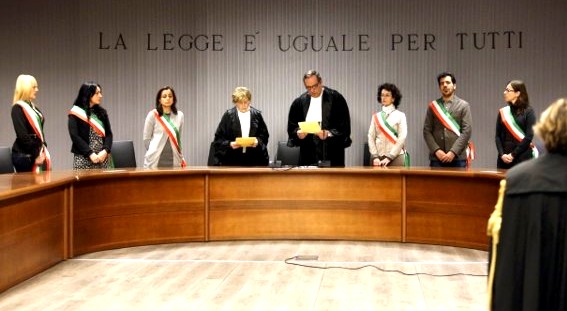
The statement is sharp and quite brief. Judge Nencini confirms that both Knox and Sollecito are confirmed guilty. The 2009 Massei verdict is upheld.
The sentences are 25 years in priosn for Raffaele Sollecito and 28.6 years in rpison for Amanda Knox including the 3.8 years for the calunnia already served. Each must also incur financial penalties.
Both may be locked in the sex offenders wings as both were confirmed convicted with a sex-crime component. Both may face further charges for false accusations of crimes in their books and in the media, as may some of their more strident “supporters”.
Few in the US and UK seem to realize, but the evidence presented at trial in the first half of 2009 was in fact overwhelming. In the US and UK it is probable no appeal would even have been allowed, as the appeal grounds were so flimsy.
Nothing was undermined at the Florence appeal. In fact the evidence became STRONGER as another trace of Knox was found on the big knife. Innuendo about DNA contamination was sharply rejected in face of zero evidence or even scenario.
Please read our case overview here which links to some vital posts and touches on several of the defense’s illegal tricks.
That includes the corrupting of the 2011 appeal, which is well understood in Italy but not registering with most US and UK media - Sndrea Vogt has begun reporting on part of it, the illegal meddling with the Hellmann DNA consultancy
..
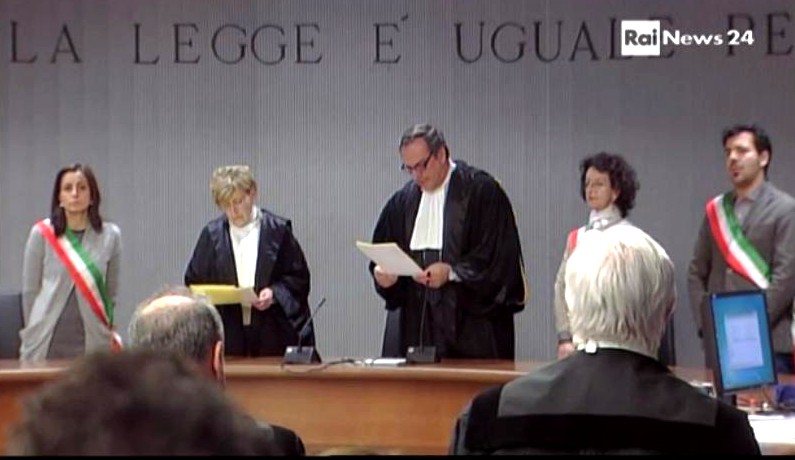
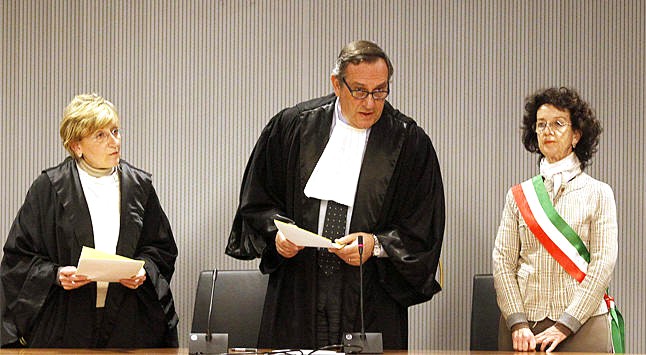
Thursday, January 30, 2014
Appeal Session #10: After Defense Remarks Panel Of Judges Reaches Its Decision: BOTH GUILTY
Posted by Our Main Posters
Verdict: Both are confirmed guilty
The Massei verdict is upheld. The sentences are 25 years for Raffaerle Sollecito and 28.6 years for Amanda Knox. Sollecito is to have his passport taken away.
For Knox they could issue a worldwide Interpol Red Notice for immediate arrest around the world, even before going for extradition, to stop her dishonest self-serving blabberings.
Take a look at our conjectures down the bottom of this post on the judges’ deliberations. Looks like we got One, Two and Four right and Knox will be named in the judges report as the prime instigator.
That will hardly help her resist extradition. And it will please Guede and Sollecito, who both always hint at that.
To CNN: yet again this is NOT double jeopardy. Read the extradition treaty. It was ONE valid trial (2009) and now ONE valid and failed appeal (2014). Not two trials.
Tweets from our main poster Machiavelli
26. All these many thanks are so warming and comforting; I’m glad my contribution was useful among the many others.
25. No measure taken for expatriation of Knox because she is a US citizen currently in her own country.
24. Passport withdrawn for Sollecito and movement restriction within the boundaries of the state of Italy. No restriction for Knox.
23. Ruled that Knox’s royalties belong to Lumumba,
22. Accessory penalties/settlements: established Knox stinks, ordered Dalla Vedova to change jobs… (!)
21. Her calunnia sentencing has been increased from 3 years (Hellmann-Zanetti) to 3 years and 6 months.
20. To be more precise: Knox has been sentenced to 28 years and 6 months. (She has already served four years).
19. Massei sentence confirmed (25y), Knox sentence increased to 28 years because of calunnia aggravation
18. Bongiorno very agitated
17. Five minutes and a half from a verdict?
16. Judge declared the verdict will be 3D and distributed goggles [?]
15. Sollecito was in the courtroom. Appeared nervous.
14. Said because of the greatness of their power they should acknowledge reasonable doubt.
13. Ghirga emphasized discretional power of the court. Said they have big power to acquit.
12. In point of law: Ghirga said evidence must be considered as a whole in compliance with SC, but assessment should find reasonable doubt
11. Said no blood on knife because of negative TMB and blood confirmatory tests.
10. Ghirga: cited the claims about picograms, said amount is not the point, the problem is test repetition and other conditions
9. Says bruise at back of head is compatible with frotal fight against single aggerssor (disagreement with Introna on this too)
8. Ghirga: Meredith’s blue sweater was removed before fatal stabbing, as for Torre’s opinion. Admitas he disagrees with Sollecito’s defence.
7. Ghirga talked about: Meredith’s blue sweater, an echimosis at back of her head, DNA laboratories and Stefanoni’s quantization
6. Ghirga recalled a small number of details of physical evidence and autopsy.
5. Dalla Vedova asked acquittal, did not specify, whereas Ghirga instead, talking later, invoked reasonable doubt.
4. D.V. says believes there are other Supreme Court rulings in his favor.
3. D.V. emphasized the single pieces of evidence should be assessed each one in parceled out, atomized way before considering the whole
2. DV focused on evidence assessment procedure, quoted SC rulings.
1. Dalla Vedova’s talking lasted a short time, and not very orderly.
Tweets from reporter Barbie Latza Nadeau
28. Court: Amanda Knox Is Guilty. See more in The Daily Beast.
27. Kercher family members being briefed by lawyers and British consulate.
26. Sollecito must surrender all documents, passports, identification,
25. Its 25 years for sollecito and 28.6 years for amanda knox
24. Amanda Knox [2009] guilty verdict upheld, sollecito [2009] guilty verdict upheld.
23. Judges and jury enter.22. Huge security presence ahead of verdict including riot police outside and in public area of courtroom amandaknox tense
21. meredithkercher sister stephany and brother lyle have arrived in court for verdict.
20 Prosecutor Crini has arrived in court for verdict in amandaknox appeal
19. Clerk says between 9-930 local time judges will return. Says judges want “utter silence no shouting or clapping”
18. Court clerk says verdict will be delivered between 9 and 9:30 tonight.
17. Amanda Knox “˜Afraid’ Of Today’s Court Verdict http://thebea.st/LeteHD via @thedailybeast
16. Court clerk says at 8pm she will go back to judge to find out if and when they are ready to deliver verdict.
15. Court clerk says “presumably verdict at 8:00 but everyone come back at 7:00
15. Court clerk just announced that at 6pm local they will tell us when the verdict will be announced.
14. Mario Spezi, author of Monster of Florence, has come to court to hear amandaknox verdict.
13. Lawyers for amandaknox and sollecito, journalists already in courtroom ready for verdict that come come any time from 5pm Florence time.
12. Lunch has just been brought in to judges and lay jury deliberating amandaknox case. No wine.
11. Refreshments just delivered to jury members in amandaknox new appeal, espresso, cappucino and possibly a tea…
10. Judge in amandaknox new appeal says decision will not come before 5pm.
9. amandaknox lawyer asks court to absolve his client.
8. amandaknox lawyer says the dna on the knife attributed to meredithkercher can not be verified, can not be considered.
7. amandaknox lawyer Ghirga tells court they have to look at all the evidence to reach verdict, not value pieces here and there.
6. amandaknox lawyer says you can’t put two innocent people in jail to cover up mistakes of judicial system.
5. amandaknox lawyer tells judge: you cannot convict for murder in the name of Italy when evidence is ‘probably’ attributed to a defendant.
4. amandaknox lawyer says you can’t cancel out evidence, says Amanda’s rights were violated, she was in shock when she accused Lumumba.
3. sollecito in court by his dad who said they are all nervous for verdict over drinks with journalists at hotel bar last night.
2. amandaknox lawyer CDV says they are serene going into verdict because they believe in her innocence,
1. Court in session. One of the jurors wearing a shiny spangled skirt, rest dressed soberly.
Tweets from Freelance Reporter Andrea Vogt
13. Meredith Kercher’s brother: It was the best we could have hoped for, but amanda knox verdict not cause for celebration.
12. amanda knox guilty verdict upheld. Her lawyer Carlo Dalla Vedova said he has called her. She did not cry. She was “petrified.”
11. amanda knox conviction upheld. sentenced to 28 years and six months. Sollecito to 25. Ordered passports to be taken.
10. Meredith’s sister and brother are accompanied by British consulate officials. A hush has come over the courtroom.
9. The family of meredith kercher has arrived in court to hear the verdict.
8. Even most experienced Italian court reporters not predicting what long wait for amanda knox verdict means. Could go either way
7. amanda knox verdict is expected at 9 or 9:30. Clerk reminds about the decorum expected:no applause, shouting, cheering, etc
6. Standing room only in Florence court as media, legal teams, public await amandaknox verdict (timing soon to be announced).
5. Judge and jury in amandaknox case have retreated for deliberations. Verdict not before 5 pm Italy time.
4. amandaknox Judge : we will not give a verdict before 17, after that,can come any time, but will announce with lots of advance notice.
3. Ghirga: We wait anxiously and seriously for justice for Meredith. But doing justice means doing it also for amandaknox and RS.
2. amandaknox lawyers are in court. Ghirga: “siamo fiduciosi, serene, emotionati.” (Roughly: “Trusting, calm, on edge”).
1. Verdict expected late today in amandaknox appeal….
Freelance Reporter Andrea Vogt On Website
From The Freelance Desk
Amanda Knox is expected to wait out the verdict in her appeal at her mother’s Seattle home (likely with American television news networks present) while Raffaele Sollecito was in court with his father and a friend. Sollecito made no remarks upon leaving for the courthouse in a taxi, surrounded by a pack of cameras. Meredith Kercher’s sister, Stephanie, and brother, Lyle, are also expected in Florence today for the court’s decision, expected in the evening hours….
Conjectures on what the judges may be discussing
The panel of judges is in effect deciding now on positions that must be sustained in 2-3 months in a 100-400 page document that must be okayed by the Supreme Court.
This might be what the quite long (by Italian standards, they will have discussed the case intermittently) jury discussion today is focused upon. Here are four possible issues.
Possible issue one
As sharp Italian media are pointing out, Prosecutor Crini departed from the Massei scenario and suggested a different driver in one key respect.
Like Mignini and Micheli in 2008 he assigned the role of prime mover to Amanda Knox and not to Guede. (Nobody ever assigned it to Sollecito.)
Maybe hoping to give RS and AK a break the Massei jury (not neccessarily the judge himself) assigned to Guede the primary role in starting the attack, saying maybe he forced himself upon her.
Then maybe the other two came in from next door, and set about helping him to subdue Meredith.
They just happened to have two knives handy, and even Massei assigns the fatal blow to Knox.
Crini argued as more likely that Knox started to quarrel with Meredith over hygiene or drugs or money and the other two joined in and for 15 minutes the attack escalated.
In this Knox and not Guede is assigned the role of prime mover.
The judges may want to accept this and seek to assign Knox a harsher punishment accordingly.
(Neither court seems to have settled on a convincing reason for why the big knife was brought down from Sollecito’s house which looks to us at minimum forboding.)
Possible issue two
This relates to the scenario in the comment above. Judge Massei lopped five years off the routine sentences by conjuring up “mitigating factors”.
One such factor was the duvet placed over Meredith which Massei thought could be a sign of remorse, surely by a woman.
Many including psychologists never agreed with this. It could have been simply an aversion to all the blood, which Knox on the stand in 2009 chillingly described as “yucky”.
If so the sentences awarded could creep up beyond the durations decided on by Massei. Above 25 and 26 years.
Possible issue three
This is an alternative to One and Two above. The judges might think the crime was more like a manslaughter, an attack that ended in murder
But not intended as such and never agreed to by two of the attackers. In which case sentences could be a lot lighter.
Possible issue four
There are financial award considerations. How much to award to whom, plus maybe ways to ensure their payment in light of Knox blatantly stiffing Patrick..
[Below: image of the judges and lay judges arriving this morning]
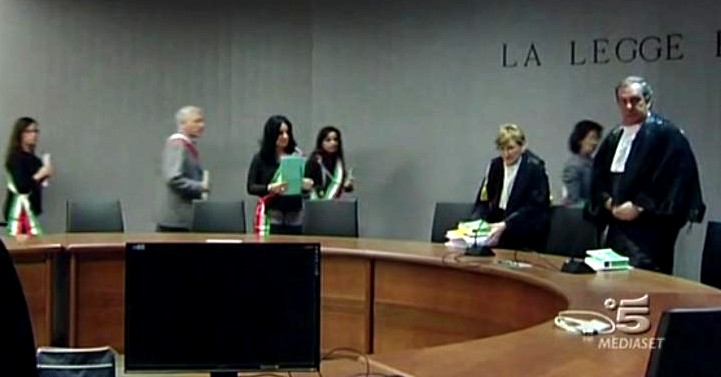
Wednesday, January 29, 2014
Continuing Enormous Strength Of The Evidence Which Defenses Seem To Have Abysmally Failed To Shake
Posted by Our Main Posters
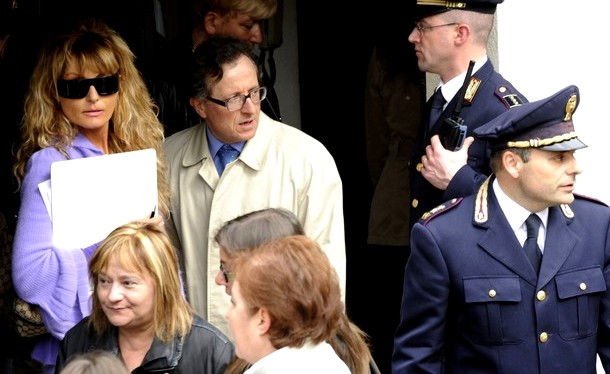
[Above Judge Massei at Meredith’s house with panel-of-judges members early 2009]
What this Florence appeal is REALLY about
There is much confusion on this, sowed by various at-distance commentators who don’t read the Italian press or the excellent English-language reporters right there on the spot.
This is NOT a re-trial. This is a FIRST appeal by Sollecito and Knox against the guilty verdicts and sentences Judge Massei awarded them late in 2009. It is being repeated since their defense teams helped to bend the first (Hellmann court) iteration of the first appeal two years ago.
Since the end of 2009 they have been provisionally guilty of murder and other crimes, subject to final ratification by the Supreme Court, which has not yet occurred. Judge Hellmann decided to let them out and travel worldwide. Many think his decision on this was legally weak.
Was there prime-face justification for this appeal?
Under US and UK law many lawyers and judges think the judicial process could have stopped right there in the US and UK, because the grounds for appeal the defenses came up with in 2010 were essentially innuendo about DNA and little else.
But the pro-defendant Italian system unlike almost any other in the world allows appeals if any are filed to automatically go forward. So the bent, stretched-out and illegally wide-scope Hellmann appeal of 2011 was the first result.
Appointed apparently in illegal circumstances to replace the highly-qualified Judge Chiari (the lead-judge for criminal appeals, who then resigned) Judge Hellmann was ill-qualified at best - he was not a criminal judge and had handled only one other murder trial before, which he got wrong.
The annulment of the first first-appeal
The Supreme Court very rarely completely annuls any trial or appeal. But in this case in March 2013 it did just that, on a large number of grounds.
The 2013-2014 Nencini appeal court in Florence starts with the early-2010 Massei report plus new guidelines from the Supreme Court. Nothing else floated since early 2010 counts.
This case seems to break all records ever for (1) defamatory and dishonest PR; (2) dirty tricks, many illegal, by the defense; (3) dishonesty by those accused in two defamatory books and multiple statements to the press; and (4) greed and blood money while the process still goes on.
Contempt of court trials and investigations have commenced to push back, Amanda Knox is particularly at risk because her book contains false accusations of crimes (again) and she defies the Supreme Court in not paying Mr Lumumba his damages though she destroyed his business.
Suggested Reading: Part One
Sooner or later (no necessarily now) read all the must-read posts in this group here, all the open questions for Sollecito in this group here, and all the open questions for Amanda Knox in this group here.
1. Getting up to speed on the 2008 RS and AK charges
Our four-part summary of Judge Micheli’s report is the best thing to read (scroll down) especially Micheli’s argument that ONLY Knox had any reason to re-arrange the crime scene - she lived there and needed to point evidence away from herself.
Also read Amanda Knox’s and Raffaele Sollecito’s many mutually contradictory attempts to provide one alibi for both.
2. Getting up to speed on the 2009 RS and AK trial
The prosecution performed brilliantly and left the defenses despondent and out-classed (paving the way for more dirty tricks in 2010-13) and we were told that two defense lawyers nearly walked off.
To get a flavor of how badly the defenses did, read this post and this post on Knox’s absolutely disastrous stint on the stand. From there the defense portion of the trial really went downhill.
To get a flavor of how well the prosecution did read about the damning reconstruction (known about in all of Italy but not widely elsewhere) described here and here.
3. Getting up to speed on the Massei 2010 Report
The most vital read of all is the short-form version of the Massei Report by Skeptical Bystander and a team on PMF dot Org. If you have no time to read any posts, make sure to read that.
The other vital reads, not here but on the new “The Murder Of Meredith Kercher Wiki”, are the overview of the evidence and the chart of evidence synopsis.
We had a large number of posts starting in 2010 checking out whether in all details the Massei Report got it right. Read this first take.
4. Getting up to speed on the crime-scene scenario
Vital to understanding the Massei court’s crime-scene scenario which Prosecutor Crini espouses, wade through this excellent reconstruction of the crime in a long Powerpoint by our lawyer James Raper with the Powerpoint whizz Kermit.
About Part Two
The next part of our most-recommended reading from 2010 to 2014 will follow after the verdict to help correct the ill-informed debate over whether Knox goes back to jail.
It hardens the case and in our view leaves no holes for RS and AK to wiggle through. We will point the post to those arguments that anyone tries to raise.
Tuesday, January 28, 2014
Strong Proof That Raffaele Sollecito Also Stabbed Meredith Kercher Causing The Lesser Wound.
Posted by Ergon
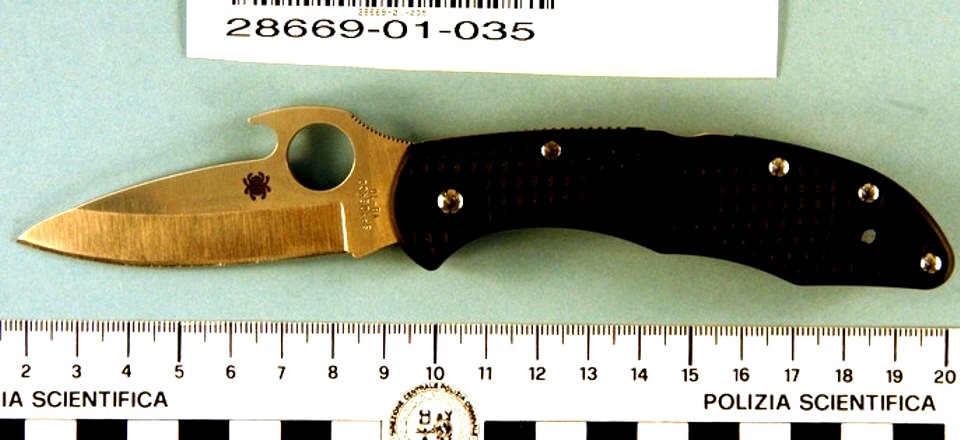
Sollecito’s “pocket knife” is a Spiderco Delica4 Emerson Opener made for killing people
Overview
This picks up from from my previous post just below on the large knife that overwhelming evidence shows was wielded by Amanda Knox.
Sometime around Thursday, January 30, 2014, Judge Nencini of the Florence Appeals Court will be delivering the verdict of the court in the case of Amanda Knox and Raffaele Sollecito, at which time all arguments regarding the knives, staged burglary, DNA and forensics, false accusation, wonky alibis, and reliability of witnesses will be rendered moot.
There will be nothing left but an argument about the legality of the process, and not the evidence, presented by the defenses if they choose to at some point in the fall of 2014 before Cassazione, the Supreme Court in Rome.
But, until then, we are left with the indelible image of Raffaele Sollecito’s defense attorney Giulia Bongiorno a few days ago flailing with two knives in court, arguing (1) the kitchen knife doesn’t fit the major wound, and (2) there’s a missing knife, which she suggested was a pocket knife wielded by Rudy Guede.
In part I, I proved that the imprint of the knife on the mattress sheet matched the kitchen knife, in shape and dimensions. We have already seen in other articles here on TJMK, that there is a definitive match with Knox and Meredith Kercher’s DNA on the murder weapon, and now we know it was transported to the cottage, to leave its mirror image on the bed.
Here, in part II, is a recap of Massei on the knives and wounds inflicted on Meredith Kercher, and how the defense continually tried to divert us away from the knife image by saying it did not fit the dimensions of the major wound.
Also we will have Frank Sfarzo and Bruce Fischer’s amateurish attempts to prove that Rudy Guede caused the knife wounds. And it will try to address what happened to the missing knife that inflicted the lesser wound on Meredith, and who might have wielded it.

Closeup of the stabbing end of the Spiderco knife shown at the top
Deliberate false claims
One of the many myths surrounding this case was that investigators had no reason to seize the kitchen knife from Sollecito’s flat, and when I showed the photos from Conti’s lab, with the deep scratches on it, that it may have been altered in some way, and denying that was where some of Meredith’s DNA might have been trapped. IIP even posted an out of focus picture some time back to prove that point.
Here is Frank Sforza on the late and unlamented Perugia Shock.‘ANY KNIFE COULD HAVE DONE THAT WOUND’
End of a Myth
Frank Sfarzo, Sept. 19, 2009
Quote: “It was introduced in the room, it was taken out of the box with all precautions, it was shown to them like a relic. They could have a look at it from a distance, and see, or believe to have seen, the groove into which the biological material of Meredith was found.” And:
“Amanda Knox’s lawyer Carlo Dalla Vedova brought him (independent expert Professor Cingolani) to say something very clear about the main one: any single-edge knife is compatible with Meredith’s larger wound.”
Here is Bruce Fischer on the error-ridden Injustice In Perugia.
Quote: “The knife was a common kitchen knife retrieved from the kitchen of Raffaele Sollecito. The knife was chosen from the drawer because it looked clean. (Editorial note: it was also, deeply scratched and nicked)
No blood was on the blade.
No DNA was on the blade.
The knife doesn’t match most of the wounds on Meredith.
The knife doesn’t match the bloody imprint left on the bed.
The photographic evidence shows that Raffaele’s kitchen knife is to (sic) large to match the bloody imprint on the bed.
At 4 cm from the tip the knife blade is 2.2 cm wide, while the injury (i.e. the small wound) is 1.5 cm wide. Raffaele’s kitchen knife could not have caused the wounds. The knife blade is also too long to have inflicted the large wound.” (Ed. note: Here they are conflating the dimensions of the lesser wound with the knife that inflicted the major wound, to cause confusion)
This is typical of the dishonesty of Bruce Fischer, who was only parroting what the defense experts had been saying in Massei’s court.
Fischer’s source was these posts from the now discredited Frank Sfarzo: Knife doesn’t match wounds and Knife doesn’t match imprint on bed.
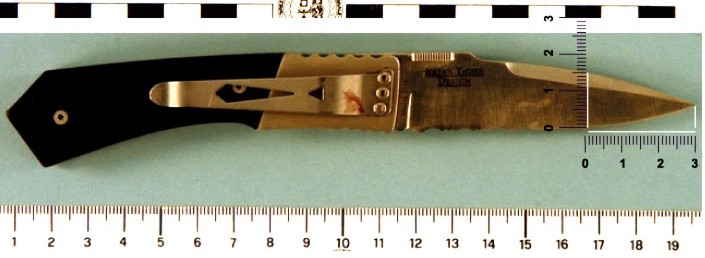
An image of Sollecito’s 2004 model Brian Tighe knife specifically made for killing people
From the Massei Report
This is from the excellent PMF translation.
P. 99: The witness (investigator) recognized it when shown Exhibit 36 as that same knife (pages 176 and 177, hearing on February 28, 2009). He remembered that in the drawer there were other knives, but he collected what was later indicated as Exhibit 36. It had the following dimensions: blade 17 cm. and handle of dark colour 14 cm. He recalled that in Sollecito’s bedroom they found another knife whose total length was 18cm, with an 8cm. blade.” (This would be his Brian Tighe pocket knife, the Spyderco flick knife was seized from his person when he was arrested)
P.135: The stab wound corresponding to the injuries on the right side of the neck was indicated as being a little wound of very small dimensions with a very small path. The path of the wound is 4cm long and only 1.5cm wide. The blade used to make this wound must have had a width of 1.5cm at 4cm from the point. This blade only entered 4cm into the neck “because it encountered the angle of the jaw” (page 33 of the transcripts).
P.147: Professor Vinci testified at the hearing of August 18, 2009. He considered the subject of the “bloody stains” found on the undersheet in Meredith Kercher’s room. In relation to these stains, on the basis of graphics given in the report dated June 30, 2009, he asserted that the knifeprint found on the undersheet in Meredith’s bedroom could have been made either by an 11.3cm knife blade, or by a 9.6cm knife blade together with a mark 1.7cm long left by the handle of the same knife. In either case, the blade could not be wider than 1.3/1.4 cm. (Ahem)
P. 154: Prof Cingolani: He clarified that irregularities present on the blade, on the edge of the blade, could have created the rippling in the wounds.
P. 157: the examination of the wound on the right part of the neck, which had absolutely incompatible dimensions: 1.5cm long and 0.4cm wide with a depth of 4cm.
p.164: she was therefore struck on the right latero-cervical region with a single-edged blade which produced a wound with dimensions of 1.5cm by 0.4cm, with a penetrating depth of 4cm: an action not relevant in determining the cause of death but intended, as before, to subdue Meredith Kercher’s resistance.
p.166: the width of the (kitchen knife) proximal third [blade one third of the distance from the handle] is 3cm.
p166: Along the edge, there was evidence of irregularities in the form of thin ridges at 2.2cm and at 11.4cm from the tip.
p. 167: The experts and consultants who were examined during the course of the trial, taking into examination the various wounds present on the neck, excluded the compatibility of the knife Exhibit 36 and the wound inflicted on the right latero-cervical and having the following dimensions: 1.5cm by 0.4cm, with a depth of 4cm in an oblique upwards direction. They in fact showed that the confiscated knife, at a distance of 4cm from the tip, has a width of approximately 3cm and thus almost double the 1.5cm width of the wound, a width thus incompatible with the dimensions of the blade of this knife.
p.172-3: In relation to the above, the thesis of the incompatibility of the most serious wound and the knife Exhibit 36 is held to be unacceptable, though this knife is incompatible with the 4cm-deep wound, as we have seen. Nor does this conclusion contrast with the circumstances illustrated by Sollecito Defence consultant Professor Vinci in his report relating to the “šanalyses of the haematic stained shapes discovered on the mattress cover in Meredith Kercher’s room”›.
p.175: The reconstruction offered by Professor Vinci certainly appears suggestive. Some doubt remains in the reconstruction of the dimensions of the knife derived in relation from the marks found on the bed sheet. If these marks indeed derived from the knife placed on the bed sheet, then they should in fact have been more abundant, and should have outlined the shape of the knife with greater precision, for the following reason: the knife, if it was placed on the bed sheet, was placed there immediately after it had been used to strike Meredith; therefore, the fresh and abundant bloodstains present on the blade should have been imprinted onto the bed sheet in a more evident and copious way than is actually appreciable. It cannot in any case remain unobserved that, if one of the knives used had a blade length of 11.3cm, or else 9.6 cm ““ according to what was indicated by Professor Vinci in the conclusions to his report ““ the argumentation set forth to sustain the incompatibility of the knife Exhibit 36 would not, on this alone, have any foundation.”
For the record, here are the paragraphs from the English translation of the Massei Report where Patricia Stefanoni describes the streaks and scratches on the double DNA knife and locations where samples were taken.
Judge Massei (on pg. 196) wrote about forensic expert Patrizia Stefanoni:
“She specified that trace B had been taken from a point on the face of the blade; she added that no biological trace was visible to the naked eye. However [she added that] “under considerable lighting, a series of streaks were visible to the naked eye. These streaks ran parallel to the upper part of the blade, therefore, more or less, they were parallel to this side [of the blade] and towards the point they went downward and, therefore, they followed the shape of the point. These streaks, anomalies in the metal, were visible to the naked eye under intense lighting” (page 95 of the transcript). Still in regard to the visibility of these streaks, she specified that they were “visible under good lighting by changing the angle at which the light hit the blade, since obviously the blade reflects light and thus creates shadows, making imperfections visible”.
The samples taken from the handle, in the points indicated with the letters A, D, F were taken in order to verify the possible presence of DNA by the person who grasped that knife. In particular, for sample “A”, a particular point had been chosen, “in which there’s the hand-guard” (page 95) and therefore, in all likelihood, the point where there was the most friction between the hand that grasped the knife and the handle. This sample yielded the result of Amanda Knox’s genetic profile.
The other samples yielded negative results, except the one taken from the blade, from the “scratches and streaks visible under good lighting, by changing the angle of the lighting with regards to the blade” that yielded the genetic profile of the victim (page 96 hearing May 22, 2009).”
And now we know: Dottora Patrizia Stefanoni got it right.
And some disagreement amongst the experts: p.291-2: Professor Cingolani had in fact noted and declared the following: “in the second lesion, the one that is 2 centimetres deep and 1.5 centimetres wide from corner to corner, the only thing that we are tempted to do, [albeit] in an absolutely amateurish/unprofessional way, because we only have photographs available, is to measure, assuming that only the tip entered, how wide the blade is [at a point] 2 centimetres from its tip: it is precisely 1.5 centimetres wide!”

A closeup with measurements of Sollecito’s Brian Tighe knife made for killing people
My own investigation
Here is my initial close examination first posted on PMF dot Net last summer.
Ergon Post subject: INVESTIGATION OF THE KNIVES USED IN THE MURDER Posted: Sun Jun 09, 2013 12:42 am
Investigation into the death of Meredith Kercher-THE CAUSE OF DEATH AND THE MEANS BY WHICH IT WAS OCCASIONED
The murder of Meredith Kercher was particularly bloody and brutal. Reading through Massei, pages 109- SURVEY AND EVALUATION OF THE FORENSIC RESULTS through to 158-173, THE CAUSE OF DEATH AND THE MEANS BY WHICH IT WAS OCCASIONED we are reminded of the brutality with which the attack took place, the sexual assault by more than one person, the restraining, the defensive wounds on Meredith’s hands, the torture by more than one knife, restraining by a hand over the mouth when she screamed, (even while she bled to death) and two major knife wounds, one to the left of the throat, the other, to the right. Massei rightly concludes, as did the Supreme Court, that more than one attacker was involved, and, per Massei, there was more than one knife used in the attack. The defense experts tried to draw attention away from the kitchen knife, but, reading through Massei again, I saw how they dropped clues to what the dimensions of the second knife might have been.
We know that Raffaele Sollecito had a fetish for violent porn, that he had an expensive collection of knives, and his many alibis for the night in question have been thrown out by the court. From my studies of criminal psychology, from reading both Amanda and Raffaele’s books and watching videos of their court appearances and television interviews, their psychopathology seem apparent not only to my eyes, but even to the general public that must have looked at them and decided their story somehow did not ring true, and refused to buy their books. There are indeed certain neurological deficits apparent in their demeanor that renowned German neurologist Dr. Gerhard Roth postulates shows up as a ‘dark patch’ in brain scans of all those who display criminal behaviour, and even, “The second type is the mentally disturbed criminal who looks at his world as threatening. A wrong look, one false move, he can explode and become a killer,” he said.
I was shown videos of the crime scene, and able to observe the wounds in Meredith’s neck. The scenes of the room in which the murder took place and, the neck wound, were truly horrifying to me, and showed the extent of the attack. Those images still sit in the mind, but also, cause me to want to get to the bottom of this mystery, hence, my work on the case.
I believe, observing the photos I already posted in the Evidence Files that the kitchen knife was the murder weapon that struck the fatal blow that night. I also believe, reading the pathologist’s report, that the blade that was stuck in Meredith’s neck, in the right latero-cervical area to a depth of 4 cms, was Raffaele Sollecito’s Brian Tighe pocket knife, photo also in the evidence files. Yes, no DNA or blood was sampled from it, but that only indicates it was successfully cleaned that night. My reading of Sollecito’s pathology is that he would not want to dispose of the knife he used, it being very expensive and also as an extension of his fetishistic ego. One other thing I asked to look at: The high resolution photos I posted of the bed show the outline and dimensions of two knives. I believe that both images are of the kitchen knife that struck Meredith in the left latero-cervical to cause a cut of 8-9 cms in depth, and a length of 8 cms (p. 167)
There are two exhibits of the mattress cover, one marked “J” and the other, “O”, both displaying the approximate size and dimensions of the kitchen knife, which I will explain when I post the photos. The first, “J”, has more blood because I believe the knife was placed there first and wicked on to the sheet, causing the distorted splotch at the end. By the time it was moved to its final position by the purse, “O”, it retained just enough blood to leave a clearer, indelible impression.
It was a butchery.”
One last point: Rep. 33A/B/C/D were four samples taken from a black-handled folding knife. It tested negative for blood, but, in one sample, the DNA profile matched a mix of Knox and Sollecito. The other samples were negative. Stefanoni: pp. 103-104
Looking at the images produced by my illustrator, and taking the average of the two estimates of the wound depth, 2 and 4 cms, one arrives at a blade width of 1.5 cms at 3 cms length from the tip of Raphaele Sollecito’s Brian Tighe collectors knife, on which, coincidentally, both Amanda Knox and Sollecito’s DNA was found.
Conclusion:
Raffaele Sollecito stabbed Meredith Kercher, causing the lesser wound. And my personal opinion? It was with the Brian Tighe knife, and somehow both he and Amanda Knox got their DNA on it around the same time that night.
Monday, January 27, 2014
An Investigation Into The Large Knife Provides Further Proof That This Was THE Knife
Posted by Ergon
Overview
This is the first report of an investigation (the second part follows soon) of the kitchen knife used in the murder of Meredith Kercher, RIP.
Specifically its compatibility with the imprint of a bloody knife found by police investigators on her bed under-sheet which as you will see here seems possible to prove.
Two other recent posts also concentrated on aspects of the knife as strong proof: (1) proof of both Knox and Kercher DNA and (2) proof from the throat wounds.
- Reference files are from very high definition crime scene photos not in general circulation.
- Grateful thanks to the volunteers of the Meredith Kercher community who assisted in this production
Florence Court of Appeals
This is our poster Machiavelli, tweeting from the Florence courtroom on November 26, 2013:
“(Prosecutor Alessandro) Crini stated that this kitchen knife was compatible with the knife print on Meredith’s bed sheet”.
And this is from the defense summing up on January 09, 2014:
Bongiorno: “It’s too big, not the murder weapon.”
“Bongiorno shows a picture with an envisioned “knife” (pocket knife belonging to Guede?) together with the print on the bed sheet.”
“Nobody brings a “small blow with a big knife” “You don’t use half of a big knife” (she says)
Genesis of an investigation:
To recap: evidence was been presented at the Massei court of the first instance, which accepted that the kitchen knife, containing both Meredith Kercher’s DNA on the blade (trace B) and Amanda Knox’s DNA on the handle (trace A) was the weapon that struck the fatal blow to Meredith Kercher’s throat.
At some point after the attack, the perpetrator, Amanda Knox, puts it down on the bed, leaving “hematic stains” (bloody imprints) on the mattress.
The court concludes the shape of the imprints are compatible with the kitchen knife. It also concludes, based on the size of a lesser wound that a second, smaller knife caused the wound on the other side of the neck, and, the impossibility of accepting that a single weapon inflicted both wounds.
This is what it boils down to now, as we come to the final arguments of this case on January 30, with a decision to be handed down by the court later in the day:
- Was the kitchen knife found in Raffaele Sollecito’s kitchen the murder weapon that killed Meredith Kercher on November 01, 2007?
- Did the killer leave behind proof in the form of bloody imprints on the under sheet covering Meredith’s bed?
- And is the defense trying to divert attention away from it, even though the image on the bed fits the dimensions of the kitchen knife?
- And pointing to a second knife, not ever found?
This article (to be followed by part II) was prepared to offer answers to these questions.
Methods used
As someone with a keen interest in photography, I know we see things in photographs that are not always apparent to the naked eye.
Where before we had all been misled by low definition photographs released by the defense to obscure incriminating details, I was able to obtain and view the high definition photographs shown here that proved that indeed, the bed imprints matched the seized kitchen knife, exhibit 36.
These photographs, first posted at Perugia Murder File Evidence Files have been circulating for some time, with members trying to match the knife to the bed imprints, but not, in my opinion, being able to match it exactly.
First, note that the killer placed a knife on two separate locations on the bed, marked by reference cards “J”, and “O”. (Reference photos below.)
I discarded “J”, because there was too much blood there to form an accurate measurement. The killer lifted the knife and then placed it at “O”, which gave a better image, but even then, did not match exactly. Still, it was clear the images looked like a kitchen, and not, a pocket knife as alleged by the defense.
Looking at the reference photo, I saw a double image of a knife blade at “O”. (see where there’s a curved edge of the blade? That’s what convinced me there might be a double image there)
Conclusion reached
My opinion is the knife shifted slightly when it was placed there, hence the double image, which now made a perfect match with the kitchen knife, in both instances (see reference photos).
So I got a professional illustrator and other skilled people people to do the scale drawings and produce the video you see above which seems to provide conclusive proof the murder knife was placed on the bed.
Reference photos:
Image 1 above (click for larger image): Bed II (Image J and O on under sheet, shot November 02, 2007)
Image 2 above (click for larger image): Knife II (Image O on under sheet, shot November 02, 2007)
Image 3 above (click for larger image): FOTO5BIS (Conti-Vecchiotti lab, Mar. 22, 2011)
Image 4 above (click for larger image): Knife-Bed-Vector-AllScales (To prove the scales used to match the images)
Image 5 above (click for larger image): Knife-pos-lower-hi (The knife’s first resting position at “O”)
Image 6 above (click for larger image): Knife-pos-upper-hi (The knife’s final resting position at “O”)
Next steps
There are only four more days left till the Florence Appeals Court under Judge Nencini issues its verdict. It must of course consider ALL the evidence, of which there is a preponderance that indeed suggests the verdict will, as would be proper, be guilty as charged.
Part II will be ready ASAP. It will be a recap of Massei on the knife, and how the defense continually tried to divert us away from the knife image by saying it did not fit the dimensions of the major wound. Also will have Frank Sfarzo’s misdirection and Bruce Fischer’s amateurish attempts to prove that Rudy Guede caused the knife wounds.
Happy as always to do my share for justice for Meredith Kercher.

